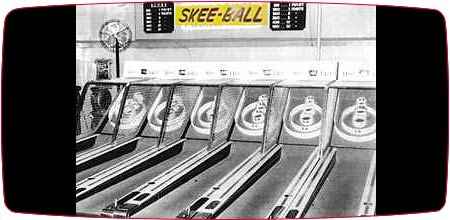Skee-Ball

Retro Coin Op Synopsis
Oh, to hold that wooden ball in your palm and know the possibilities. You’ve studied the prize case carefully. You’ve smudged the glass in the process, maybe endured a weary eye-roll from the arcade manager. But no matter. Be it the candy necklace or the magic card trick or the baton or the kazoo, you know how many tickets it will take to claim your prize, and so you know what you have to do. Roll up your sleeves, say a little prayer to the good aim gods and take a deep breath. It’s time to roll some skee-balls.
This arcade standard, a distant, distant relative of bowling, was invented and patented in 1909 by J.D. Estes of Philadelphia. Back then, the lanes were thirty-six feet long, but in 1928 they were shortened to lengths of fourteen feet, and later ten. The space-saving alleys made Skee-Ball accessible to more players, and therefore, much more popular.
Most penny arcades in the 30's had a row of Skee-Ball machines and a loot-filled display case, offering precious toy bounty as a trade-in for the tickets that Skee-Ball machines dispensed to winners. In those years, there were law enforcement officials who considered the likes of Skee-Ball and other coin-op games to be gambling mechanisms because they could award prizes. There were often restrictions put on the number of stalls an arcade could have, or worse, poor Skee-Ball would be banned from the arcades altogether.
But the persecution was soon over. Coin-op Skee-Ball was an arcade must, and even if the prizes in the glass case were different, or there was no ticket dispenser at all, the basics of the game itself were virtually the same as they were in the 1920’s: The nine wooden balls, often nicked up and battle-worn, still measured three and an eighth inches around, and still weighed about five ounces. There was also the same click as the gate opened and the balls were released from the stall’s nether regions and scooted down, like a timber centipede, into the alley on your right.
Once launched, your ball careened up the lane, over a hump, and (hopefully) up and into the scoring rings. The farther away the ring your ball landed in, the more points you got, but sneakily, the smaller the ring’s circumference. Hitting those wee, high-point rings took more than a brute toss; it took patience and aim. Right down the center... not too hard, not too soft. Find your rhythm and the balls sunk magically into that top ring, one after the other. And with those kinds of points, the prize world was your oyster.
The Skee-Ball brand name has had many different owners over the years, but has belonged to its newest family since 1985, which adopted it just in time for the boom of fun family dining centers (the Chuck E. Cheeses and Peter Piper Pizzas of suburbias everywhere) in the 80’s and 90’s. Nowadays, there are a couple of different versions of the classic alley game, including the Mega Skee-Ball, a stand-alone game because of its large size, and Skee-Daddle, with the traditional alley set-up in miniature, for those Skee-Balling kids.
Variations like ICE Ball and Smart Ball offer a bit of healthy competition for the Skee-Ball brand, but regardless of shape, size, or scoring options, Skee-Ball remains an arcade fixture today, still tempting skee-ballers to take one more roll toward prize case glory.
Arcade Machine Release History
1909 - Skee-BallArcade Game Sub Categories
redemptioncarnival
